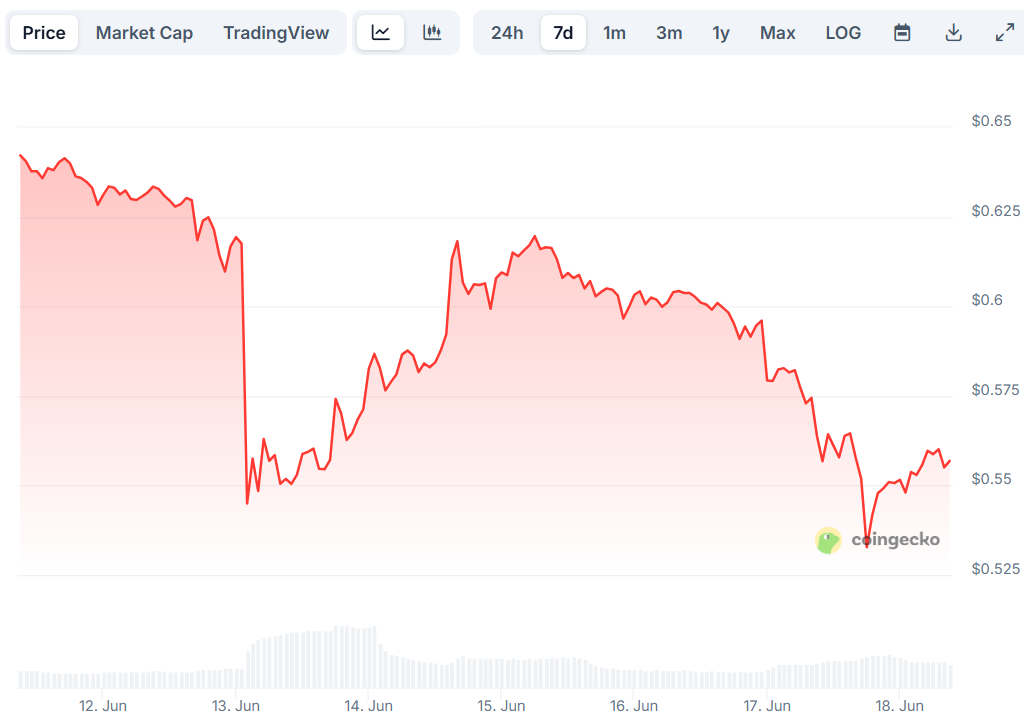TLDR
Contents
- Pi Network token declined 12% over seven days with 347.6 million coins deposited on trading platforms
- Daily volume climbed 9% to $96 million showing increased selling activity
- Pi Day 2 event set for June 28 faces skeptical community response
- Token ranks top 30 by market value but trades on limited exchanges creating liquidity issues
- Market experts identify altseason and regulatory approvals as potential price recovery drivers
The Pi Network token has declined in recent trading as users transfer large quantities to cryptocurrency exchanges. Price data shows a 12% decrease over the past seven days.
Exchange tracking reveals 347.6 million Pi tokens have been moved to trading platforms. This movement typically signals user intent to sell holdings.
Current trading sees Pi Network valued at $0.55 per token, representing a 3.08% daily decline. Market activity has intensified with daily volume rising 9% beyond $96 million.

The upcoming Pi Day 2 event on June 28 has generated limited enthusiasm among network users. Many participants express doubt about potential announcements from development leadership.
Community member Mr Spock emphasized the need for concrete information over promotional messaging. His statement called for updates across five specific areas: user verification numbers, application usage data, business partnerships, network growth statistics, and token supply details.
🚨 Pi2Day is Coming. Let’s Keep It Real.
We don’t need wild promises.
We don’t need hype.What we do need — and what could make all the difference — are a few solid updates from the Core Team:
✅ Total KYC-verified users
✅ Latest app download stats
✅ Real partnership news… pic.twitter.com/cpvSb1ZsLW— Mr Spock 𝛑 (@MrSpockApe) June 18, 2025
Polling conducted by Dr Altcoin revealed widespread pessimism among community members. Survey responses showed most users maintain minimal expectations for the scheduled event.
One respondent suggested the development team might use the event to generate interest while selling their own token holdings. This sentiment reflects broader trust concerns within the user base.
Trading Infrastructure Limitations
Pi Network maintains its standing among the top 30 digital assets by total market value. Despite this ranking, the token encounters significant trading constraints.
Research by analyst DAO World identifies availability on just five cryptocurrency exchanges. This restricted access limits trading opportunities and affects overall market liquidity.
The token’s trading characteristics differ markedly from comparable assets in similar market cap ranges. Limited order book depth means large transactions can cause substantial price fluctuations.
Reduced exchange presence creates potential for sharp price movements during periods of increased interest. Single large purchases or coordinated buying could drive rapid valuation changes.
Current infrastructure challenges may actually benefit future price action if demand returns. The scarcity of trading venues could amplify any positive momentum once market conditions improve.
Market Recovery Prerequisites
Industry analysts suggest Pi Network’s price trajectory remains linked to broader cryptocurrency market cycles. Traditional patterns show alternative coins gain momentum following Bitcoin’s advance to new peaks.
Bitcoin faces current resistance around $108,000 according to technical analysis. Multiple attempts to break higher have failed, while public interest metrics show declining search activity.
This consolidation phase often precedes major breakouts, particularly when institutional money continues flowing into the market. A successful Bitcoin rally typically triggers Ethereum gains, followed by capital moving into smaller tokens.
Regulatory developments could provide another catalyst for price appreciation. Potential approval of spot exchange-traded funds for alternative cryptocurrencies would create new institutional access routes.
ETF authorization in major financial markets would establish formal investment channels for institutional buyers. Combined with accommodative monetary policies, such approvals could drive substantial inflows to tokens like Pi Network.
Dr Altcoin outlined essential internal developments required for sustainable price growth. Key factors include practical utility, price consistency, and authentic user engagement.
Network Development Requirements
Pi Network reports more than 70 million registered users, though many have not completed necessary account transitions. A substantial portion of the total token supply remains locked within the network structure.
Functional utility as a payment method requires price stability comparable to traditional currencies. Without consistent valuation, business adoption for everyday transactions remains unlikely.
Price projections suggest Pi Network may need valuations above $10 for effective ecosystem operation. This level would enable practical daily transactions for typical users, most holding 1,000 tokens or fewer.
Until these fundamental requirements are met, the token’s role as a transactional currency may remain theoretical rather than practical.
Current market dynamics continue showing downward pressure as users prepare for potential selling ahead of the Pi Day 2 event.
Exchange deposit patterns indicate user positioning for possible exits rather than accumulation ahead of the scheduled announcement.


